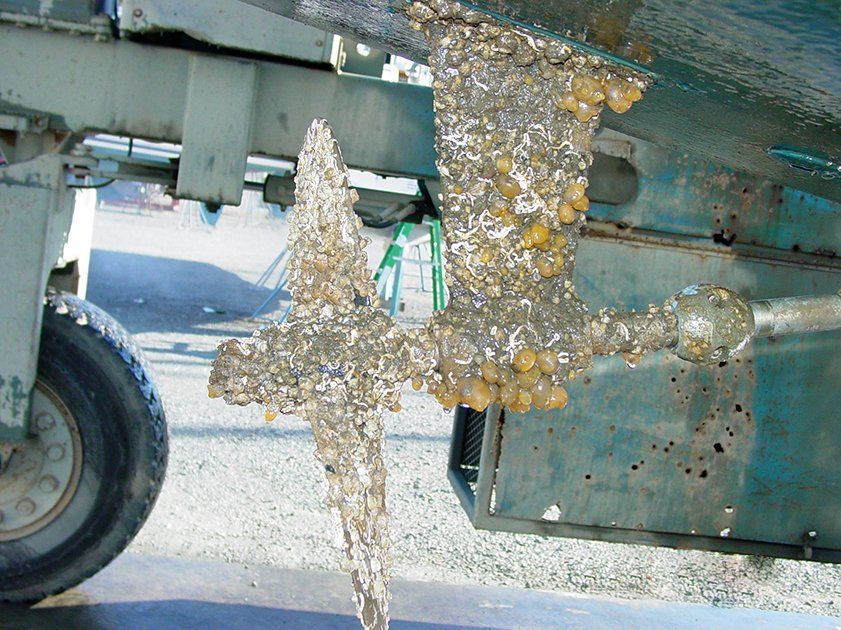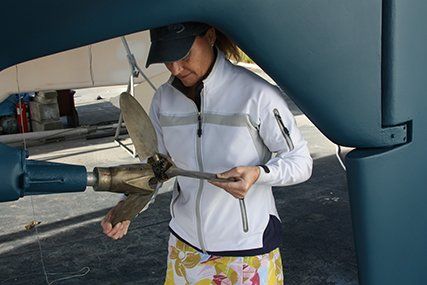A cheap, effective antifouling paint for a propeller is as rare as a good pun. The coating must not only ward off all marine growth, it must present a smooth slick surface that can stand up to the constant water friction when the boat is under power. And in the case of a folding prop, the coating must also adhere in nooks and crannies and, in some cases, even withstand metal-to-metal contact. These demands are well beyond the reach of any run-of-the-mill marine coating. Thus, we embarked on our search for-wait for it-a prop(er) paint.
Yes, you can paint a bronze propeller with conventional, copper-based hull paint, but it wont do much good, since the more noble metals in the bronze prop will eventually waste away the copper biocide. Don’t even think about painting an aluminum outdrives or prop with a copper paint, or the reverse will occur-the more noble copper will attack the outdrive alloys. Even with the right preparation, regular bottom paint tends to wear quickly on a prop due to increased water friction.

Practical Sailors search for longer lasting prop paints has led us down many rabbit holes, we’ve experimented with several different prop paints with varying degrees of success, although none of the results so far have been dazzling. Some of our testers have had better success with dedicated slick prop paints such as PropSpeed. In our testing, however, mostly in Chesapeake Bay, no prop paint had lived up to our increasingly faint hope that the paint repel growth as effectively as our hull paint.
For previous articles on this topic check out our report on the dedicated propeller paint PropSpeed (seePSFebruary 2014 online), and a more detailed report on prop paints in general (seePS July 2010 online).
We also looked at Mussel Buster (seePS October 2011 online), a baked-on powder coating that, like PropSpeed, relies on its slick, hard coating (as opposed to biocide) to prevent barnacles from adhering. Other products our testers tried include Feldtens Nano propeller spray treatment, an inexpensive product that appeared no more effective than others. Like other prop paints we have tested, both the Prop One (formerly Prop Gold) and Velux Plus showed signs of failure after less than six months of use. The Velox Plus (primed, left, and painted, middle) began to flake off the prop (right), but it was still fighting barnacles.
Lately, we have advised sailors to take one of two options:

Option 1:Blast the prop to bare metal, prime with Interlux Interprotect or a similar barrier-coat epoxy, and then paint with a conventional hard bottom paint. (Although the epoxy theoretically prevents galvanic reaction between dissimilar metals, copper-based paints are to be avoided.) The trick with using a conventional bottom paint (sprays like Interlux Trilux 33 or Pettit Alumaspray are easier to apply) is getting it to adhere, thus the epoxy primer. Although there are options other than epoxy for priming a prop, because of health concerns, these etching primers are not considered do-it-yourself friendly (although they were used that way for years).
Option 2:Use Pettit Barnacle Barrier, a spray zinc product that has given us a years worth of protection in the Chesapeake. Because the prime-and-paint routine hasn’t delivered dividends commensurate with our effort, we’ve found that applying multiple coats of the relatively inexpensive Pettit Barnacle Barrier is the most practical option for boats that haul out annually. (Readers have also reported unsatisfactory performance with Barnacle Barrier.)
Option 3:Take your pick of the dedicated “slick” prop coatings we’ve tested. Results will vary (as our tests have shown) but all should provide longer lasting protection than either of the above options if they are applied as directed. However, the added cost might not be worth it to the boater who hauls and paints each year.
If you’d had good (or bad) results with any of these options–or something else–we’d like to hear about your experience. Be sure to include the boat’s type, name, home port, and location and pattern of use during the period the paint was in use (i.e. sailed weekly, daily, monthly in San Francisco Bay. . . ). You can respond by email at practicalsailor@belvoir.com. Comments are also appreciated.





































My cruising ground is the Chesapeake and we keep the boat in Annapolis. I’ve been using PropSpeed with mixed results and decided to try Pettit’s Running Gear Guardian anti-fouling paint. Less expensive and much easier to apply than PropSpeed. I launched the boat in May and hauled her mid-November. Barely a season. The results were very poor. Barnacles covering everything – propeller, strut and shaft. Really bad. Very disappointing as I had followed the directions to the tee.
I sail in Georgia and Florida and keep my Catalina 310 in St. Simons Island, GA. The waters here are very demanding due to strong currents and high temperatures and the boat stays in the water year round for 2-3 years between bottom jobs. Only a high copper ablative paint and monthly diving and cleaning keeps the bottom in good shape. I have used Prop Speed with very good success because the barnacles will fly off under use but during my recent bottom job it had to be reapplied due to it having been scraped off partially. But we could not get it in a timely manner due to supply chain issues so instead tried Petit Barnacle Barrier on prop and shaft. After 3 months and 2 dives it appears to make the barnacles easy to remove. The diver can flick them off with little effort but it does not seem to prevent them adhering like Prop Speed. Unsure yet if they will come off during use under power. As of now I will likely return to Prop Speed in 3 years during the next bottom job but will monitor performance between now and then.